Rajasthan Board RBSE Class 12 Biology Chapter 26 Man-Nervous System
RBSE Class 12 Biology Chapter 26 Multiple Choice Questions
Question 1.
What is the unit of the nervous system?
(a) Nephron
(b) Neuron
(c) Brain
(d) Spinal cord
Answer:
(b) Neuron
Question 2.
Temperature controlling centre in the brain of man is:
(a) Pituitary gland
(b) Diencephalon
(c) Hypothalamus
(d) None of the above
Answer:
(c) Hypothalamus
![]()
Question 3.
A function of the parasympathetic nervous system is:
(a) Dilation of pupil
(b) Secretion of sugar in the liver
(c) Increase heartbeat
(d) Stimulate secretion of saliva
Answer:
(d) Stimulate secretion of saliva
Question 4.
The scientist who worked on conditioned reflex action:
(a) Mendel
(b) Pavlov
(c) Darwin
(d) Evan Wilmut
Answer:
(b) Pavlov
![]()
Question 5.
Number of cranial nerves present in Man are:
(a) 10 Pairs
(b) 10
(c) 12 Pairs
(d) 12
Answer:
(c) 12 Pairs
RBSE Class 12 Biology Chapter 26 Very Short Answer Type Questions
Question 1.
Name the found in brain.
Answer:
Brain Ventricles.
Question 2.
How many cranial nerves are found is a man?
Answer:
12 Pairs.
![]()
Question 3.
Which is the longest cell?
Answer:
Nerve cell (Neuron)
RBSE Class 12 Biology Chapter 26 Short Answer Type Questions
Question 1.
Which are two parts of the autonomous nervous system?
Answer:
- Sympathetic Nervous System
- Parasympathetic Nervous System
Question 2.
Why the name peripheral nervous system is given?
Answer:
Because the peripheral Nervous System originates from the central nervous system and it innervates all body organs.
Question 3.
Write one function of the following:
- Cerebrum
- Cerebellum
- Medulla oblongata
- Hypothalamus
Answer:
- Cerebrum: It controls thinking, Argument, Planning, Memory etc.
- Cerebellum: It controls body balance & Muscles coordination.
- Medulla oblongata: It controls most of the involuntary activities of the body such as heartbeats, breathing, BP etc.
- Hypothalamus: It has centres for hunger, satiety, thirst, temperature control etc.
![]()
Question 4.
Write the main parts of the brain.
Answer:
- Forebrain: Cerebrum, Diencephalon
- Midbrain: 4 optic lobes
- Hindbrain: Cerebellum, Pons, Medulla
Question 5.
Write the name of the fluid-filled in the cavities of the brain.
Answer:
Cerebro – Spinal Fluid (CSF)
RBSE Class 12 Biology Chapter 26 Essay Type Questions
Question 1.
Explain simple reflex action (arch) with the help of well-labelled diagram depicting a transverse section of the spinal cord and nervous pathway of reflex action.
Answer:
Spinal Reflex Arch:
- The nerve pathway involved in a reflex action is called a reflex arch. It includes the following 5 parts –
- Sensory organ: Receptors on the body which receive an external or internal stimulus.
- Sensory Nerve: Sensory nerve carries impulse from sensory organs to the spinal cord.
- The nerve centre of spinal cord or Interneurons Centre of actions.
- Motor nerve: Transmit, impulse away toward the spinal cord.
- Effector organs: These organs complete their actions with a response to impulses received through a motor nerve.
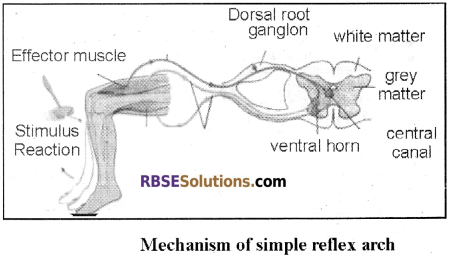
Question 2.
Describe the structure of the brain of a man with a diagram.
Answer:
Structure of Brain:
The human brain is divisible into 3 parts –
- Forebrain
- Cerebellum
- Brain stem
1. Forebrain:
In human beings, the forebrain includes two parts –
- Cerebral hemispheres or cerebrum
- Diencephalon
2. Cerebrum:
- It forms 2/3 part of the brain and a longitudinal fissure divides it into two hemispheres.
- Both the hemispheres remain connected internally by the corpus callosum.
- Each cerebral hemisphere consists of five lobes –
- Frontal lobe
- Parietal lobe
- Temporal lobe
- Occipital lobe
- Insula lobe
- The insula lobe is not visible externally.
- The frontal lobe is the largest. A central sulcus separates the frontal and parental lobes which are also called as the fissure of Ronaldo. Similarly, a lateral cerebral fissure separates the frontal and the temporal labels which are also called as the fissure of Sylvius.
- The parental and the occipital lobes remain separated by a parieto-occipital fissure. The outer 2 to 4 mm thick part of the cerebrum is called cortex or grey matter. It consists of 10% of the total neurons of the brain. The cortex exhibits distinct gyri (ridges) and sulci (furrows).
- These gyri and sulci increase the surface area of the cortex by 3-times. The inner mass of the cerebrum is called as white matter.
Functions of the cerebrum:
- Frontal lobes: They control memory, reasoning, thinking, determination, emotions, judgment, planning, experience, concentration, will power and personality. They also control voluntary muscles and interpret many sensations.
- Parietal lobes: They interpret sensory perception of touch, pain, cold, heat etc. They also control speech and handicraft. They also associated with the understanding of the thoughts.
- Temporal lobes: They interpret and decode sound. In addition to language comprehension, they also interpret smell and auditory sensations.
- Occipital lobes: The interpret and decode visual sensations particularly sensations concern with colours and shapes. They also control eye movements.
- Insula lobes: They coordinate memory and other parts of the cerebrum.
2. Diencephalon:
- It is divisible distinctly into epithalamus, thalamus and hypothalamus.
- Thalamus forms 80% of the diencephalon and it functions as relay centre of the sensory perception of taste, touch, hearing, vision, pain, heat etc. It interprets these sensations and sends motor drives concerning to the voluntary movement.
- The hypothalamus includes about 12 large nuclei and it is divisible into four parts –
- Supraoptic part: It is situated just above the optic chiasma. Its axons enter into the pars nervosa of the pituitary gland.
- Tuberal part: It is the broadest and the middle part. It is attached with the pituitary through a stalk called infundibulum.
- It has a projection, the tuber cinerarium around the infundibulum.
- Mammillary part: It is the posteriormost part which bears two small and round projections, the mamillary bodies. It controls reflex actions concern to smell.
- Preoptic part: It is a small part which is situated anterior to the supraoptic part. It controls some autonomic reflex actions.
The function of the hypothalamus:
- It controls coordination between psyche & body and neurons & endocrine systems.
- It has centres of hunger, thirst, satiety, and temperature control.
- It includes nuclei secreting oxytocin. and vasopressin hormones.
- It controls a diurnal rhythm and sleep.
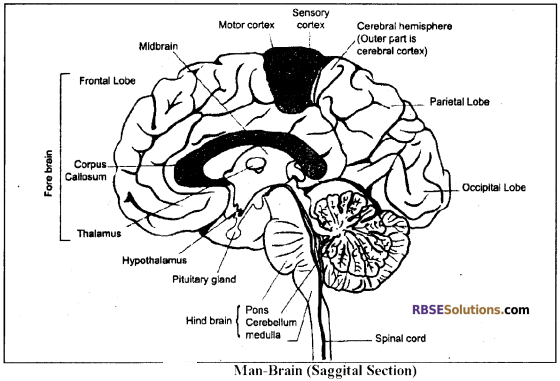
2. MidBrain:
It is the middle part of the brain and also called as mesencephalon. It consists of two parts –
1. Corpora Quadri-gamine:
- It includes four optic lobes which are collectively called as Corpora Qudrigemina.
- Out of 4 lobes, two lobes are superior optic lobes and two are inferior optic lobes.
- The optic lobes remain joined to the dorsal surface of the midbrain with the help of Tatum.
- The optic lobes receive stimuli related to vision & hearing.
2. Cerebral peduncle:
- It is also called as Crura Cerebri.
- It is a bundle of nerve fibres which connects the cerebral cortex to the spinal cord & other parts of the brain.
3. HindBrain:
- It is posterior or terminal part of the brain.
- It consists of three parts:
- Cerebellum
- Pons Varolli
- Medulla Oblongata
1. Cerebellum: It is the second largest. It part consists of two lobes. Dorsal side of cerebellum is well developed. Its two main functions are –
- Maintenance of posture or equilibrium.
- Coordination of muscular activities.
2. Pons Varolli: It lies just above medulla oblongata and below cerebral peduncle. It joins both lobes of the cerebellum and also other parts of the brain.
- It is made up of white matter.
- It contains Pneumotaxis centre for regulation of breathing. It also controls chewing, saliva secretion, the release of tears and eye movements.
3. Medulla Oblongata: It is the posterior-most part of the brain, It is triangular and situated between the pons and spinal cord. Its cavity is called metachronal and medulla continues as the spinal cord. Functions of medulla oblongata are:
- It has controlling centres of breathing, coughing, swallowing etc.
- It has controlling centres for heartbeats, blood pressure, peristalsis in alimentary canal & other involuntary activities.
4. Brain Ventricles:
- The mammalian brain is hollow and the cavities are called ventricles. These ventricles are lined by ependymal epithelium and are full of cerebrospinal fluid (C.S.F.).
- The brain has 4 ventricles viz., I, II, III & IV. I & II ventricles are found in the cerebral hemispheres and are also called as paracoels.
- Each paracoels forms a rhinocoel in the olfactory lobe which is also called as zero ventricles.
- Both the paracoels open into a third ventricle through a foramen of Monro.
- III ventricle is also called as dioctyl & it is found in the roof of the diencephalon.
- The 3rd ventricle opens into IV ventricle through a narrow duct, the iter or aqueduct of Sylvius. The item is found in the cerebellum.
- IV ventricle is also called as metachronal & it is found in the medulla.
- There are two choroid plexus in the ventricles viz.,
- Anterior choroid plus: It is found in the roof of the diaconal.
- Posterior choroid plus: It is found in the roof of the metacoel. The choroid plus consists of pia mater & the network of blood capallaries. The anterior choroid plus secretes CSF and the posterior choroid plus absorb CSF & secrete it into the subarachnoid space.
- There are three apertures in the posterior choroid plus to absorb the CSF viz.,
- Foreman of Magendie – One
- Foramen of Luschka – two
- There are arachnoid villi in the subarachnoid space. These villi absorb CSF & return it into the venous blood.
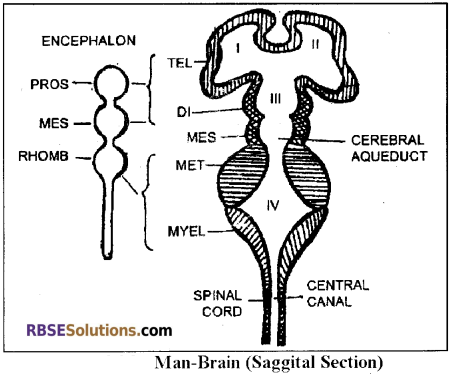
![]()
Question 3.
Describe the cranial nerves of mammals.
Answer:
- Various vital activities of the body are controlled & coordinated by two systems –
- Nervous System
- Endocrine System
- This chapter deals with the study of the Nervous System.
- The nervous system is divided into 3 heads –
- Central nervous system: It includes the brain & spinal cord.
- Peripheral nervous system: It includes cranial & spinal nerves.
- Autonomous nervous system: It includes the sympathetic & parasympathetic nervous system.
- A nerve cell or neuron is the structural and functional unit of the Nervous System.
- The space between the neurons is occupied by neuroglial cells in the nervous system.
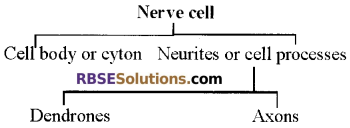
| Dendron | Axon |
| One or two or absent | Always one |
| Branched near the cyton | Branched distally & the branches are called as telocentric |
| Broad at the base & narrow at the ends | Almost uniform in diameter |
| Presence of Nissl’s granules | Absent |
| Carry nerve impulse towards the cyton | Carry impulse away from the cyton |
| Presence of cytoplasmic organelles in the basal part | Absence of cytoplasmic organelles |
- The cyton has a large & round nucleus, minute neurofibrils, cytoplasmic organelles & many Nissl’s granules. The Nissl’s granules are ribosomes & made up of RNA & proteins.
- However, the centrosome is absent. Hence, the nerve cell never divides.
- Nissl’s granules are the groups of lamellae which are attached with ribosomes. They synthesize proteins actively.
- The nerve cells increase in size along with body growth.
- The neurons are of 3 types on the basis of cell processes viz.,
- Unipolar:
- It has only one axon.
- They are found in invertebrates & vertebrate embryos.
- Bipolar:
- It has one axon & one dendron.
- They are found in eyes, cochlea & olfactory epithelium.
- Multipolar:
- It has one axon & many dendrites
- Most of the vertebrates have multipolar neurons.
- Unipolar:
- On the basis of the structure of axon, the neurons are of two types
- Myelinated or Medullated: The axon is bounded by a myelin sheath
- Non-myelinated or Non-medullated: The axon is not bounded by a myelin sheath.
![]()
Question 4.
Describe reflex action.
Answer:
Reflex Action:
- A reflex action is a rapid automatic response to a stimulus without conscious thought in the body. The response is instantaneous and involuntary.
- There is no control of brain on reflex actions.
- For example:
- A person withdraws hand instantly on touch to a pointed pin or hot utensil.
- Salivation in the mouth on right or smell or thought of good favourite food.
- Reflex actions are to two types:
- Simple or unconditional reflex action
- Acquired or conditional reflex action
1. Unconditioned Reflex action:
- They are natural or congenital.
- Learning is not required.
- Examples:
- Instantly closing of eyelids when any object comes close.
- Instantly coughing when any food particles/any liquid enters into the trachea.
- Contraction of a pupil in strong light.
2. Conditioned or Acquired Reflex action:
- This reflex action needs learning training or experience.
- Russian Scientist of physiology Evan Pavlov explained it by his experiment on the dog.
- Experiment on Dog – Pavlov starts ringing a bell just before the food is given to Dog. Later on, he observed that there is salivation in Dog’s mouth on ringing bell even without giving food.
- Examples:
- We instantly brake our vehicle when any object comes in front of it all of sudden.
- Tying of shoelaces even though we are talking to somebody else.
- Running away of dog, when we just bend down towards the ground as dog pretends that we are picking a stone to throw on him.
- Standing up of student as soon as a teacher enters into class.
Mechanism of Reflex Action:
- Fibres of the spinal cord and motor fibre of ventral root play a special role in a reflex action.
- For example, pinprick on the skin stimulates sensations. Which stimulate dendrites of somatic sensory fibres. These fibres transmit stimulus to the neurons in the dorsal ganglia of the spinal nerve.
- Terminal node of these cells sends stimulus to dendrites of nearest motor nerves. Here sensory induction becomes motor stimulus.
- Axons of motor cells are fibres of ventral root and they carry stimulus up to legs, where contraction in muscles and produce movement of legs.
- These actions are very fast and in total it is called reflex action.
Spinal Reflex Arch:
- The nerve pathway involved in a reflex action is called a reflex arch.
- It includes the following 5 parts –
- Sensory organ: Receptors on the body which receive an external or internal stimulus.
- Sensory Nerve: Sensory nerve carries impulse from sensory organs to the spinal cord.
- The nerve centre of spinal cord or Interneurons Centre of actions.
- Motor nerve: Transmit, impulse away toward the spinal cord.
- Effector organs: These organs complete their actions with a response to impulses received through the motor nerve.
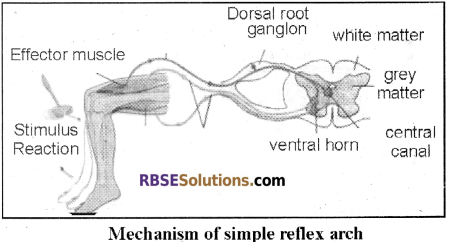
![]()
Question 5.
Describe spinal nerves in detail.
Answer:
Spinal Nerves:
- These nerves arise from the spinal cord.
- There are 31 pairs of spinal nerves.
- All spinal nerves are of mixed type as they contain both sensory and motor neurons.
- Every spinal nerve passes out through every two vertebrae of the vertebral column through an intervertebral foramen.
- On the basis of their origin, the spinal nerves are named as follows below.
| Description of Spinal nerves found in Man | ||
| Name of Nerves | Numbers | Location |
| Cervical spinal nerves | 8 Pairs | 1st vertebrae to below the cervical vertebrae |
| Thoracic spinal nerves | 12 Pairs | Below each thoracic vertebrae on both side |
| Lumbar spinal nerves | 5 Pairs | Below each lumbar vertebra on both sides |
| Sacral spinal nerves | 5 Pairs | Near the second cervical level of the spinal cord |
| Coccygeal Spinal nerves | 1 Pair | In the lower part of sacral plexus. |